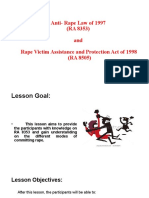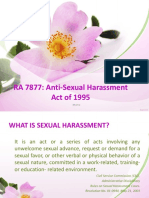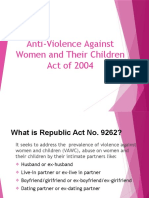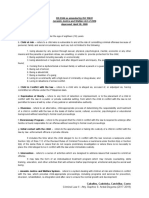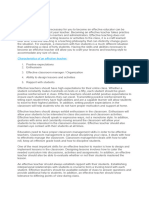Notes On RA 7610 Child Abuse Law
Notes On RA 7610 Child Abuse Law
Uploaded by
braindead_91Copyright:
Available Formats
Notes On RA 7610 Child Abuse Law
Notes On RA 7610 Child Abuse Law
Uploaded by
braindead_91Original Description:
Original Title
Copyright
Available Formats
Share this document
Did you find this document useful?
Is this content inappropriate?
Copyright:
Available Formats
Notes On RA 7610 Child Abuse Law
Notes On RA 7610 Child Abuse Law
Uploaded by
braindead_91Copyright:
Available Formats
R.A 7610 SPECIAL PROTECTION AGAINST CHILD ABUSE Child Abuse Law June 20, 1992 OUTLINE I.
Policy, Principles and Definitions; II. Program; III. Child Prostitution and Sexual Abuse; IV. Child Trafficking; V. Obscene Publications and Indecent Shows; VI. Other Acts of Child Abuse; VII. Sanctions for Establishments; VIII. Working Children; IX. Indigenous Communities; X. Armed Conflict; XI. Remedial Procedures; XII. Common Penal Provisions; XIII. Final Provisions. SECTION 2. DECLARATION OF STATE POLICY AND PRINCIPLES. To provide special protection to children; Provide sanctions; The State shall intervene in behalf of the child; The best interests of children shall be the paramount consideration.
a) Psychological and physical abuse, neglect, cruelty, sexual abuse and emotional maltreatment; b) Any act by deeds or words which debases, degrades, or demeans the intrinsic worth and dignity of a child as a human being; c) Unreasonable deprivation of his basic needs for survival, such as food and shelter; or d) Failure to immediately give medical treatment to an injured child resulting in serious impairment of his growth and development or in his permanent incapacity or death. CLASSIFICATION Art III. Child Prostitution and Sexual Abuse. Art IV. Child Trafficking. Art V. Obscene Publication and Indecent Shows. Art VI. Other acts of child abuse. ARTICLE III. CHILD PROSTITUTION AND SEXUAL ABUSE. Unlike the RPC where a prostitute must be a female, under RA 7610, a child, whether male or female may be a prostitute. PROSTITUTION AND SEXUAL ABUSE. Causes Prostitution: -Money; -Profit; -Any other consideration. Sexual Abuse: -Coercion, -Influence of any adult, syndicate or group
CHILDREN Children refers to persons below 18 years old or those of age but are unable to fully take care of themselves from abuse, neglect, cruelty, exploitation or discrimination because of a physical or mental disability or condition. CHILD ABUSE REFERS TO MALTREATMENT, WHETHER HABITUAL OR NOT, AND INCLUDES:
OFFENDERS a. Those who engage in, promote, facilitate or induce child prostitution.
1. Procurer (pimp/bugaw) 2. Induce another to be a client; 3. Take advantage of influence/relationship; 4. Threaten or use violence;or 5. Giving monetary consideration, goods or other pecuniary benefit. b. Those who commit the act of sexual intercourse or lascivious conduct with a child exploited in prostitution or subjected to other sexual abuse. *If the child is under 12 yrs old, the offender shall be liable for statutory rape/acts of lasciviousness under the RPC. c. Those who profit or derive advantage from child prostitution. The manager or owner of the establishment where the prostitution takes place.
desire of any person, bestiality, masturbation, lascivious exhibition of the genitals or pubic area of a person. Child subjected to other sexual abuse Furthermore, it is inconsequential that the sexual abuse occurred only once. As expressly provided in Section 3 (b) of R.A. 7610, the abuse may be habitual or not. (Olivarez)
NOT LIMITED TO PROSTITUTION. As expressly provided in Section 3 (b) of R.A. 7610, the abuse may be habitual or not. It must be observed that Article III of R.A. 7610 is captioned as Child Prostitution and Other Sexual Abuse: because Congress really intended to cover a situation where the minor may have been coerced or intimidated into lascivious conduct, not necessarily for money or profit. The law covers not only child prostitution but also other forms of sexual abuse. (Olivares)
OLIVARES vs CA GR No. 163866, July 29, 2005 The elements of sexual abuse under Section 5, Article III of R.A 7610 are as follows: 1. The accused commits the act of sexual intercourse or lasciviousness conduct. 2. The said act is performed with a child exploited in prostitution or subjected to other sexual abuse. 3. The child, whether male or female, is below 18 years of age. SEC. 32, ART. XIII, of the IRR of RA 7610 defines lasciviousness conduct as: The intentional touching, either directly or through clothing, of the genitalia, anus, groin, breast, inner thigh, or buttocks, or the introduction of any object into the genitalia, anus or mouth, of any person, whether of the same or opposite sex, with an intent to abuse, humiliate, harass, degrade, or arouse or gratify the sexual
AMPLOYO vs PP GR No 157718 April 26, 2005 Thus pursuant to the foregoing provision [Sec.5(b)], before an accused can be convicted of child abuse through lascivious conduct on a minor below 12 yrs of age, the requisites for acts of lasciviousness under Article 336 of the RPC must be met in addition to the requisited for sexual abuse under Secition 5 of Rep. Act No. 7610. R.A. 7610 1. The accused commits the act of sexual intercourse or lascivious conduct; 2. The said act is performed with a child exploited in ART. 336 1. That the offender commits any act of lasciviousness or lewdness; 2. That it is done under any of the ff circ:
prostitution or subjected to other sexual abuse; and
3. The child, whether male or female, is below 18 years of age.
-by using force or intimidation; or -when the offended party is deprived of reason or otherwise unconscious; or -when the offended party is under 12 yrs of age; and 3. That the offended party is another person of either sex.
Consensual sexual intercourse or even acts of lasciviousness with a minot who is 12 yrs old or older could constitute a violation of Section 5(b) of R.A. No. 7610. For section 5 (b) punishes sexual intercourse or lascivious conduct not only with a child exploited in prostitution but also with a child subjected to other sexual abuse. (PP vs OLAYON, GR No 171863, Aug 20, 2008)
ARTICLE 266-A. RAPE (RA 8353, Oct 22, 1997) Rape is committed: 1. Man, carnal knowledge of a woman: a) Through force, threat, or intimidation; b) When the offended party is deprived of reason or otherwise unconscious; c) By means of fraudulent machination or grave abuse of authority; and d) When the offended party is under twelve (12) years of age or is demented, even though none of the circumstances mentioned above be present. SEXUAL ASSAULT 2. By any person who, under any of the circumstances mentioned in paragraph 1 hereof, shall commit an act of sexual assault by inserting his penis into another persons mouth or anal orifice, or any instrument or object, into the genital or anal orifice of another person. *Finger is considered an instrument. Note that inserting any instrument or object does not include mouth. Section 5 (b) may even cover a case of consensual sexual intercourse.
Section 2 (g) of the Rules and Regulations on the Reporting and Investigation of Child Abuse Cases, promulgated to implement R.A. No. 7610 Sexual abuse includes the employment, use, persuasion, inducement, enticement or coercion of a child to engage in, or assist another person to engage in, sexual intercourse or lascivious conduct or the molestation, prostitution, or incest with children. (Olayon)
CONSENSUAL SEXUAL INTERCOURSE For consensual sexual intercourse or lascivious conduct with a minor, who is not exploited in prostitution, to thus fall within the purview of Sction 5)b) of RA No 7610. persuasion, inducement, enticement or coercion of the child must be present. (OLAYON
PP vs LARIN GR No 128777 Oct 7, 1998 It is an accepted rule that different people react differently to a given situation or type of situation. One cannot reasonably expect uniform reactions from victims of sexual assault. Carlas submissiveness to Larins lascivious conduct does not exonerate him from criminal liability, as the law does not require physical violence on the person of
the victim. Moral coercion or ascendency is sufficient.
ATTEMPT TO COMMIT CHILD TRAFFICKING. 1. When a child travels to a foreign country alone w/o valid reason and w/o clearance from the DSWD or written permit from parents or guardian. 2. When a pregnant mother executes an affidavit of consent for a consideration 3. Recruiting women or couples to bear children for the purpose of a child trafficking. 4. When a hospital personnel or employees of a clinic or local civil registrar simulatesbirth for the purpose of child trafficking 5. When a person engages in the act of finding children among low-income families, hospitals, clinics,etc. for the purpose of child trafficking.
PP vs MATIAS GR No 186469 June 13, 2012 Below 12 years of age, Article 266A(1)(d) of the RPC, reclusion perpetua. 12 years or older, the offender should be charged with either sexual abuse under Section 5(b) of RA 7610 or rape under Article 266-A (except paragraph 1[d]) of the RPC.
ATTEMPT TO COMMIT CHILD PROSTITUTION. 1. Any person not being a relative of a child; 2. Is found alone with the child inside a room or cubicle of an, inn, hotel, motel, pension house, apartelle or other similar establishment, vessel, vehicle or any other secluded area; 3. Under circumstances that would lead a reasonable person to believe that the child is about to be exploited in prostitution or other sexual abuse. THERE IS ALSO AN ATTEMPT TO COMMIT CHILD PROSTITUTION WHEN: Any person receives services from a child in a sauna parlor or bath, massage clinic, health club and other similar establishments.
ARTICLE V. OBSCENE PUBLICATION AND INDECENT SHOWS Any person who hires, employs, uses, persuades, induces, or coerces a child to perform in obscene exhibitions and indecent shows, whether live or in video, pose, or model in obscene publications or pornographic material is liable under this provision. ARTICLE VI. OTHER ACTS Section 10 (a) Any act of child abuse, cruelty or exploitation or be responsible for other conditions prejudicial to the childs development, but not covered by the RPC. SECTION 10 (a) vs SEC 5 (b) As Section 10 refers to acts of child abuse prejudicial to the childs development other than child prostitution and other sexual abuse under Section 5, attempt to commit child prostitution, child trafficking,
ARTICLE VI. CHILD TRAFFICKING There is child trafficking when a person engages in trading and dealing with children including but not limited to the act of buying and selling of a child for money, or for any other consideration, or barter.
attempt to commit child trafficking, and obscene publications and indecent shows, the Court of Appeals did not commit grave abuse of discretion in holding that xx sexual abuse (as defined under Section 5) xxx is a completely distinct and separate offense from child abuse (as defined under Section 10). (Olayon) De Ocampo vs Secretary of Justice, 2006 Jan 25, GR No 147932 Petitioners single act of illegally banging the heads of her students had two distinct victims, namely Ronald and Lorendo. Therefore, petitioner has to face prosecution for cruelty to each victim. For Ronalds death, petitioner is being charged with homicide under Article 249 of the RPC in relation to Section 10(A), Article VI of RA 7610 punishable by reclusion perpetua. However, this does not mean that petitioner is being charged with the distinct offenses of homicide and child abuse for Ronalds death. On the pther hand, for her cruelty to Lorendo, petitioner is being charged with violation of Section 10(A), Article VI of RA 7610 punishable by prion mayor in its maximum period. DE GUZMAN vs PEREZ, GR No. 156013, July 25, 2006 The law expressly penalizes any person who commits other acts of neglect, child abuse, cruelty or exploitation or be responsible for other conditions prejudicial to the childs development including those covered by Article 59 of PD 603 but not covered by the RPC. The neglect of child punished under Article 59(4) of PD 603 is also a crime (known as indifference of parents) penalized under the second paragraph of Article 277 of the RPC. Hence, it is excluded from the coverage of RA 7610. SECTION 10 (b)
Any person who shall keep in his company a minor 12 yrs or under or who is 10 yrs more his junior in any public or private place. Exempted are those related w/in the 4th civil degree of consanguinity or affinity or any bond recognized by law, local custom, tradition, or acts in the performance of a social, moral or legal duty.
SECTION 10 (c) Any person who shall induce, deliver or offer a minor to any one prohibited by this act to keep or have in his company a minor. SECTION 10 (d) Any person, owner, manager or one entrusted with the operation of any public or private place of accommodation, whether for occupancy, food drink or otherwise, including residential places, who allows any person to take along with him to such place or places any minor. SECTION 10 (e) Any person who shall use, coerce, force or intimidate a street child or any other child to: 1) beg 2) act as conduit or middlemen in drug trafficking or pushing; or 3) conduct any illegal activities perpetua SECTION 11. SANCTIONS ON ESTABLISHMENTS. All establishments and enterprises which promote or facilitate child prostitution and other sexual abuse, child trafficking, obscene publications and indecent shows, and other acts of abuse shall be immediately closed and their authority or license to operate cancelled, without prejudice to the owner or manager thereof being prosecuted under this Act and/or the RPC.
SECTION 12. EMPLOYMENT Children may be employed: 1) under the sole responsibility of his parents or legal guardian and where only members of the employers family are employed: no danger; primary and/or secondary education. 2) In public & entertainment or information through cinema, theater, radio or television is essential: -parent or guardian -DOLE a. ensurer the protection, health, safety and morals of the child; b. measures to prevent the childs exploitation or discrimination; and c. continuing program for training. SECTION 14. PROHIBITION Advertisements involving: -alcoholic beverages Intoxicating drinks -tobacco and its byproducts and -violence CHILDREN, ZONES OF PEACE. SECTION 22. Children as Zones of Peace. Children are hereby declared as Zones of Peace. It shall be the responsibility of the State and all other sectors concerned to resolve armed conflicts in order to promote the goal of children as zones of peace. WHO MAY FILE COMPLAINTS Offended party Parents or guardians Ascendant or collateral relative within 3rd degree of consanguinity Officer, social worker, representative of a licensed child-caring institution Officer or social worker of the DSWD
Brgy. Chairman Atleast 3 concerned, responsible citizens where the violations occurred. (Art IX, Sec 27)
SECTION 29. CONFIDENTIALITY At the instance of the offended party his name may be withheld from the public until the court acquires jurisdiction over the case. SECTION 29. UNLAWFUL Editor, publisher, and reporter or columnist in case of printed materials, announcer or producer in case of television and radio broadcasting, producer and director of the film in case of the movie industry, to cause undue and sensationalized publicity of any case of violation of this Act which results in the moral degradation and suffering of the offended party.
You might also like
- IRS Rev of ElectionDocument4 pagesIRS Rev of ElectionTitle IV-D Man with a plan100% (12)
- R A 11930 - Anti OSAEC and Anti CSAEM Act 1Document33 pagesR A 11930 - Anti OSAEC and Anti CSAEM Act 1Jennica90% (10)
- Salient Features of RA 7610Document28 pagesSalient Features of RA 7610Pevi Mae Jalipa85% (13)
- RA 9208 Vs RA 10364 (Anti Trafficking of Persons)Document23 pagesRA 9208 Vs RA 10364 (Anti Trafficking of Persons)Stella C. Atienza100% (10)
- Anti-Trafficking in Persons Act Powerpoint PresentationDocument47 pagesAnti-Trafficking in Persons Act Powerpoint PresentationLoueljie Antigua88% (16)
- Salient Features of Republic Act 9262 or Anti-Violence SlideDocument19 pagesSalient Features of Republic Act 9262 or Anti-Violence SlidePevi Mae Jalipa67% (12)
- Ra 8353Document28 pagesRa 8353Zhai Soberano86% (7)
- The Anti-Trafficking in Persons Act: Doj IacatDocument60 pagesThe Anti-Trafficking in Persons Act: Doj IacatMary Grace Zarate BlandoNo ratings yet
- Chapter 4 Socialization and The Life CourseDocument41 pagesChapter 4 Socialization and The Life CourseWaqas RehmanNo ratings yet
- RA 11648 New Ati-Rape LawDocument7 pagesRA 11648 New Ati-Rape LawErnie Rodriguez100% (1)
- RA 7610 PowerpointDocument112 pagesRA 7610 PowerpointRomeo Belmonte Hugo93% (15)
- SPL - Case Digests On RA 7610Document128 pagesSPL - Case Digests On RA 7610anna bee94% (16)
- RA 9262 NotesDocument5 pagesRA 9262 NotesMJ Decolongon100% (1)
- Salient Features of The Juvenile Justice Welfare ActDocument67 pagesSalient Features of The Juvenile Justice Welfare ActDbee Dvee75% (4)
- Twin Laws On Rape - RA 8353 & RA 8505 - HandoutDocument64 pagesTwin Laws On Rape - RA 8353 & RA 8505 - HandoutPatrick TanNo ratings yet
- Safe Spaces Act Women Night WorkersDocument45 pagesSafe Spaces Act Women Night WorkersKrystine joy Godalle100% (3)
- Ra 7610Document26 pagesRa 7610nicole co100% (2)
- Anti Rape LawDocument15 pagesAnti Rape LawAurora Maramba100% (1)
- RA 9344 As Amended by RA 10630 Juvenile JusticeDocument63 pagesRA 9344 As Amended by RA 10630 Juvenile JusticeJoan Dymphna Saniel100% (5)
- 12 Principles For Payment by ResultsDocument10 pages12 Principles For Payment by Resultsaaron6king-10% (1)
- Highlights of Laws Related To Child Abuse: By: Children's Legal BureauDocument52 pagesHighlights of Laws Related To Child Abuse: By: Children's Legal BureauJoan Dymphna Saniel100% (1)
- RA 7610: Anti Child Abuse LawDocument9 pagesRA 7610: Anti Child Abuse Lawryanflores92% (25)
- Primer On Ra 7610Document2 pagesPrimer On Ra 7610Arbee Arquiza100% (4)
- VAWC RA 9262 PresentationDocument17 pagesVAWC RA 9262 Presentationivy_pantaleon67% (3)
- Special Protection of Children Against Abuse, Exploitation and Discrimination Act Republic Act 7610 (1992)Document75 pagesSpecial Protection of Children Against Abuse, Exploitation and Discrimination Act Republic Act 7610 (1992)Andrea Lizares Si100% (1)
- Ra 11648Document16 pagesRa 11648Danica Inciso100% (2)
- Anti Rape LawDocument32 pagesAnti Rape LawAngel UrbanoNo ratings yet
- Ra 9344Document49 pagesRa 9344Nolas Jay100% (1)
- Anti-Rape Law of 1997 (RA 8353)Document38 pagesAnti-Rape Law of 1997 (RA 8353)Angel Ches100% (2)
- Republic Act No. 7610 - Child Abuse LawDocument24 pagesRepublic Act No. 7610 - Child Abuse LawLeo Cruz100% (6)
- Handouts RA 9344Document22 pagesHandouts RA 9344Clark Lim100% (3)
- Be It Enacted by The Senate and House of Representatives of The Philippines in Congress AssembledDocument14 pagesBe It Enacted by The Senate and House of Representatives of The Philippines in Congress AssembledFranz MaclangNo ratings yet
- Salient Provisions of RA 9344Document54 pagesSalient Provisions of RA 9344Ella Jay Gania-Contreras100% (4)
- RA 9995 Anti Photo and Video Voyeurism Act 2009Document13 pagesRA 9995 Anti Photo and Video Voyeurism Act 2009Linda NocheNo ratings yet
- Anti-Rape Law of 1997 (RA 8353) and Rape Victim Assistance and Protection Act of 1998 (RA 8505)Document20 pagesAnti-Rape Law of 1997 (RA 8353) and Rape Victim Assistance and Protection Act of 1998 (RA 8505)Chellie Pine MerczNo ratings yet
- RA 9775 Child PornographyDocument29 pagesRA 9775 Child PornographyBilog Ang Mundo100% (1)
- RA 11313 BrieferDocument4 pagesRA 11313 BrieferSagada OperationsNo ratings yet
- Ra 7610Document33 pagesRa 7610Noel Christopher G. Belleza100% (1)
- Ra 7610Document35 pagesRa 7610mustang_lad100% (2)
- Notes On Anti-Hazing Law RA 11053, September 30, 2019Document9 pagesNotes On Anti-Hazing Law RA 11053, September 30, 2019MiltoniusKNo ratings yet
- Anti Rape LawDocument27 pagesAnti Rape LawAnonymous KvztB3100% (1)
- Revised - JJWC PAO TrainingDocument65 pagesRevised - JJWC PAO TrainingIrwin Ariel D. Miel100% (1)
- RA 7877 Anti-Sexual Harassment ACT OF 1995Document20 pagesRA 7877 Anti-Sexual Harassment ACT OF 1995aya5monteroNo ratings yet
- Sexual Harrasment LawDocument12 pagesSexual Harrasment LawLim Xu WinNo ratings yet
- Swu Lecture Ra 7610 Ra 9208 and Other Pertinent LawsDocument70 pagesSwu Lecture Ra 7610 Ra 9208 and Other Pertinent LawsZarah Milcah Matienzo BalaNo ratings yet
- Anti Violence Against Women and Their Children Act RA 9262Document22 pagesAnti Violence Against Women and Their Children Act RA 9262Angelika MarrizeNo ratings yet
- 3 RA 7610 Child Abuse LawDocument46 pages3 RA 7610 Child Abuse LawJundelle BagioenNo ratings yet
- Anti-Carnapping Act of 1972 v. New Anti-Carnapping Act of 2016Document9 pagesAnti-Carnapping Act of 1972 v. New Anti-Carnapping Act of 2016Abigail Boquiren0% (1)
- What Is The Legal Definition of "Violence Against Women and Their Children?"Document23 pagesWhat Is The Legal Definition of "Violence Against Women and Their Children?"Kim Arniño100% (2)
- RA. 11648 - New Rape LawDocument3 pagesRA. 11648 - New Rape Lawroyel arabejoNo ratings yet
- Topic - Republic Act No 11648Document20 pagesTopic - Republic Act No 11648Ronan Jeeven Maitem100% (3)
- Republic Act No. 9262: Anti-Violence Against Women and Their Children ACT OF 2004Document35 pagesRepublic Act No. 9262: Anti-Violence Against Women and Their Children ACT OF 2004Lucky Alonzo100% (1)
- RA 9262 Anti Violence Against Women and ChildrenDocument128 pagesRA 9262 Anti Violence Against Women and ChildrenJale Espanol100% (2)
- Ra 9165Document26 pagesRa 9165zbestgurl100% (1)
- RA 7610 DoctrinesDocument2 pagesRA 7610 Doctrinesanna bee100% (2)
- Ra 9775Document4 pagesRa 9775Paolo Ollero100% (1)
- Ra 11930 OsaecDocument62 pagesRa 11930 Osaecrobelyn gayagay100% (1)
- RA 3019 SummaryDocument2 pagesRA 3019 SummaryKenneth Peter Molave87% (15)
- Ra 9262 VawcDocument58 pagesRa 9262 Vawcianmaranon2No ratings yet
- RA 9208 As Amended by RA 10364Document44 pagesRA 9208 As Amended by RA 10364Ivy Clarize Amisola Bernardez100% (4)
- RA 9344 As Amended by RA 10630 - HandoutsDocument9 pagesRA 9344 As Amended by RA 10630 - HandoutsJan Re Espina CadeleñaNo ratings yet
- Notes On RA 7610 Child Abuse Law PDFDocument6 pagesNotes On RA 7610 Child Abuse Law PDFFerdinand VillanuevaNo ratings yet
- Report Criminal Law Child AbuseDocument8 pagesReport Criminal Law Child AbuseJillandroNo ratings yet
- 7 Jethro V SOLEDocument9 pages7 Jethro V SOLEbraindead_91No ratings yet
- 20 - Del Monte vs. VelascoDocument6 pages20 - Del Monte vs. VelascojannahNo ratings yet
- 9 Tiger Construction V AbayDocument10 pages9 Tiger Construction V Abaybraindead_91No ratings yet
- Phil Rabbit Bus Lines Vs Arciaga GR No L-29701 16mar1987Document4 pagesPhil Rabbit Bus Lines Vs Arciaga GR No L-29701 16mar1987braindead_91No ratings yet
- 4 Sapio V UndalocDocument12 pages4 Sapio V Undalocbraindead_91No ratings yet
- LASCO, Paulo M.: PRO VersionDocument6 pagesLASCO, Paulo M.: PRO Versionbraindead_91No ratings yet
- ALBANO, Chalum B. (SUMALBAG, Henrietta B.) : PRO VersionDocument8 pagesALBANO, Chalum B. (SUMALBAG, Henrietta B.) : PRO Versionbraindead_91No ratings yet
- Res-011405.html Disapproved AppointmentDocument4 pagesRes-011405.html Disapproved Appointmentbraindead_91No ratings yet
- Res-021174 Civil Service Resolution On Administrative MattersDocument6 pagesRes-021174 Civil Service Resolution On Administrative Mattersbraindead_91No ratings yet
- 2009 Arangote - v. - Spouses - Maglunob20181001 5466 l6ft93 PDFDocument13 pages2009 Arangote - v. - Spouses - Maglunob20181001 5466 l6ft93 PDFbraindead_91No ratings yet
- People Vs Abapo SandiganbayanDocument4 pagesPeople Vs Abapo Sandiganbayanbraindead_91No ratings yet
- Basta KayDocument21 pagesBasta Kaybraindead_91No ratings yet
- Court of Appeals: Republic of The PhilippinesDocument13 pagesCourt of Appeals: Republic of The Philippinesbraindead_91No ratings yet
- Faculty Law 2012 Session 1 Diploma Law240 231PDF 230105 082532Document10 pagesFaculty Law 2012 Session 1 Diploma Law240 231PDF 230105 0825322021202082No ratings yet
- The Art of Attraction Full Report PDFDocument61 pagesThe Art of Attraction Full Report PDFjavaclinicNo ratings yet
- Reiner Schürmann - The Ontological DiferenceDocument25 pagesReiner Schürmann - The Ontological DiferenceÖvül Ö. DurmusogluNo ratings yet
- MAST Alcohol ScreeningDocument3 pagesMAST Alcohol Screeningmysteryvan1981No ratings yet
- Lying: How To Spot A LieDocument11 pagesLying: How To Spot A LieAisamida MederbekovaNo ratings yet
- W1 - Du Plessis 2007-A Strategic Framework For Sustainable Construction in Developing CountriesDocument11 pagesW1 - Du Plessis 2007-A Strategic Framework For Sustainable Construction in Developing CountriesAzleen SyamimiNo ratings yet
- SCAT Systematic Cause Analysis Technique PDFDocument36 pagesSCAT Systematic Cause Analysis Technique PDFAndi Saputra100% (1)
- Nellie Ohr - 8.13.2019 PDFDocument332 pagesNellie Ohr - 8.13.2019 PDFWashington ExaminerNo ratings yet
- Release Form BS - 847Document1 pageRelease Form BS - 847AshleyNo ratings yet
- PDF Eruditi N1Document195 pagesPDF Eruditi N1Mariam Koblianidze0% (2)
- Devoir de Contrôle N°1 - Anglais - 9ème (2011-2012) Mme Mariem AziziDocument4 pagesDevoir de Contrôle N°1 - Anglais - 9ème (2011-2012) Mme Mariem AziziRiahi MohamedNo ratings yet
- Acc202 Managing EthicsDocument32 pagesAcc202 Managing EthicsKeoikantseNo ratings yet
- Introduction To Law - Power PointDocument16 pagesIntroduction To Law - Power PointTimothy Jevon LieanderNo ratings yet
- Discharge by BREACH: S.40 of CA1950Document4 pagesDischarge by BREACH: S.40 of CA1950Ricky LimNo ratings yet
- Danger of Smoking in The MorningDocument6 pagesDanger of Smoking in The MorningindriNo ratings yet
- Song DynastyDocument6 pagesSong Dynastyapi-243048160No ratings yet
- Indonesia ISPS ContactDocument3 pagesIndonesia ISPS Contactsontoloyo0000005No ratings yet
- Coca-Cola Bottlers v. CA: Contractual or Cuasi-Delitos)Document1 pageCoca-Cola Bottlers v. CA: Contractual or Cuasi-Delitos)huhah303No ratings yet
- Spangbergianism The BookDocument176 pagesSpangbergianism The Booknvargelis100% (1)
- Teaching ProfessionDocument21 pagesTeaching ProfessionSteven King BayawaNo ratings yet
- Royal Mail Policies On Electronic CigarettesDocument2 pagesRoyal Mail Policies On Electronic CigarettesDick PuddlecoteNo ratings yet
- Grade 12 QuestionairDocument2 pagesGrade 12 QuestionairEzer Sara'elNo ratings yet
- Wachtell Memo On Director PayDocument2 pagesWachtell Memo On Director PayDealBookNo ratings yet
- Design Act 2000Document9 pagesDesign Act 2000Bhavya GuptaNo ratings yet
- Final PaperDocument6 pagesFinal PaperMimi de TorresNo ratings yet
- Corporate Social ResponsibilityDocument5 pagesCorporate Social ResponsibilityKathc AzurNo ratings yet
- Renumbered. Syllabus LABOR RELATIONS 2020Document14 pagesRenumbered. Syllabus LABOR RELATIONS 2020เจียนคาร์โล การ์เซียNo ratings yet


































